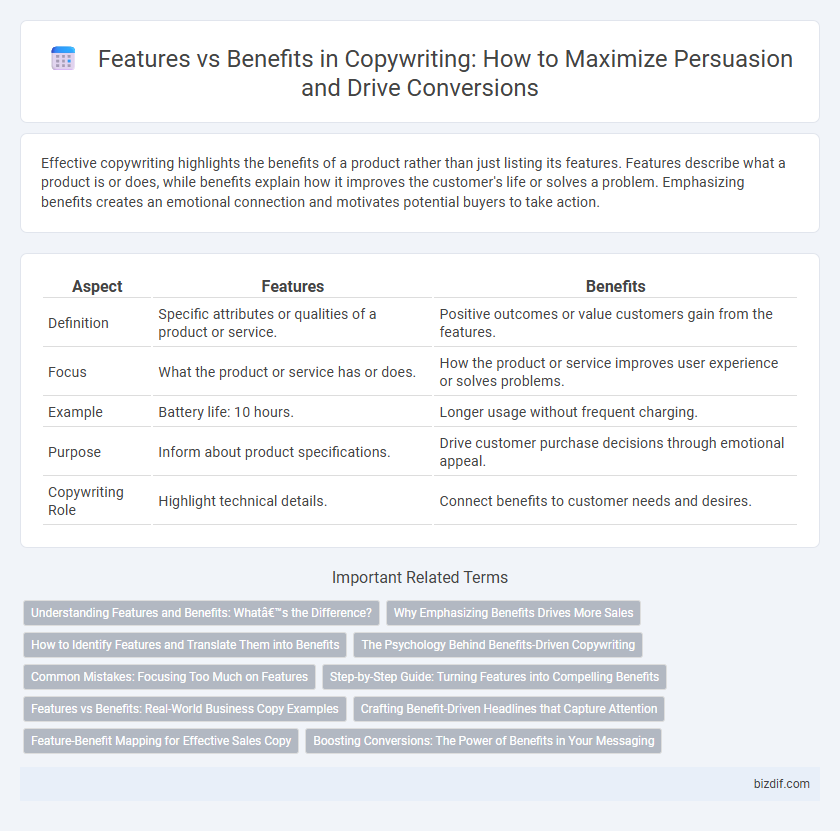Effective copywriting highlights the benefits of a product rather than just listing its features. Features describe what a product is or does, while benefits explain how it improves the customer's life or solves a problem. Emphasizing benefits creates an emotional connection and motivates potential buyers to take action.
Table of Comparison
| Aspect | Features | Benefits |
|---|---|---|
| Definition | Specific attributes or qualities of a product or service. | Positive outcomes or value customers gain from the features. |
| Focus | What the product or service has or does. | How the product or service improves user experience or solves problems. |
| Example | Battery life: 10 hours. | Longer usage without frequent charging. |
| Purpose | Inform about product specifications. | Drive customer purchase decisions through emotional appeal. |
| Copywriting Role | Highlight technical details. | Connect benefits to customer needs and desires. |
Understanding Features and Benefits: What’s the Difference?
Features describe the specific characteristics or attributes of a product, such as size, material, or functionality. Benefits explain how those features solve a problem or improve the user's experience, highlighting the value or advantage gained. Understanding the difference between features and benefits allows copywriters to craft compelling messages that resonate with the target audience's needs and desires.
Why Emphasizing Benefits Drives More Sales
Emphasizing benefits rather than features connects directly with customer needs and desires, making the product's value more relatable and compelling. Benefits answer the question "What's in it for me?" which motivates buyers by highlighting real-world outcomes and emotional rewards. Sales increase when copy shifts from technical specs to clear advantages that improve the customer's life or solve a problem effectively.
How to Identify Features and Translate Them into Benefits
Features describe the specific attributes or functionalities of a product or service, such as size, materials, or technology used. To translate features into benefits, identify how these attributes solve a problem or improve the customer's experience, highlighting value like convenience, efficiency, or emotional satisfaction. Use customer-focused language to connect features with positive outcomes, making the product more appealing and relevant.
The Psychology Behind Benefits-Driven Copywriting
Benefits-driven copywriting taps into the psychological triggers of consumers by highlighting how a product or service improves their lives, rather than just listing technical features. This approach leverages emotional resonance and personal relevance to create a stronger connection, increasing the likelihood of purchase decisions. Understanding Maslow's hierarchy of needs and cognitive biases helps copywriters craft messages that align with the audience's intrinsic motivations and pain points.
Common Mistakes: Focusing Too Much on Features
Focusing too much on features in copywriting often leads to overlooking the emotional connection and value that benefits provide to the customer. Common mistakes include listing technical specifications without explaining how they improve the user's experience or solve their problems, resulting in less persuasive messaging. Effective copy emphasizes benefits that answer the question, "What's in it for me?" to drive engagement and conversions.
Step-by-Step Guide: Turning Features into Compelling Benefits
Identify each product feature clearly, then translate its technical aspect into real-world advantages that address customer needs. Emphasize how the benefit solves a specific problem or improves the user's experience, creating emotional engagement and value. Use simple language and relatable scenarios to make benefits tangible and persuasive throughout your copy.
Features vs Benefits: Real-World Business Copy Examples
Features describe the specific attributes or functionalities of a product, such as "water-resistant up to 50 meters" or "20-hour battery life," while benefits highlight how those features solve customer problems or improve their experience, like "stay connected all day without worrying about charging." In successful business copy, highlighting benefits over features increases emotional connection and drives purchase decisions by addressing customer needs directly. For example, instead of stating "Our vacuum has a HEPA filter," effective copy would say, "Breathe cleaner air with our advanced HEPA filter that captures 99.97% of allergens.
Crafting Benefit-Driven Headlines that Capture Attention
Benefit-driven headlines emphasize the value and emotional impact your product or service offers, instantly connecting with the reader's needs and desires. Highlighting how a feature translates into a tangible benefit boosts engagement and compels action by clearly answering "What's in it for me?" Effective headlines prioritize clarity and relevance, making benefits vivid and irresistible to the target audience.
Feature-Benefit Mapping for Effective Sales Copy
Feature-Benefit Mapping transforms raw product features into compelling customer advantages, driving engagement and conversions in sales copy. Highlighting how specific features solve user problems or improve experiences enhances relevance and persuades potential buyers by addressing their needs directly. Effective sales copy leverages this technique to bridge technical details and emotional appeal, resulting in higher impact messaging and increased sales performance.
Boosting Conversions: The Power of Benefits in Your Messaging
Highlighting benefits in your copy significantly boosts conversions by addressing the audience's core desires and pain points. Unlike features that describe product attributes, benefits demonstrate how the product improves the customer's life, creating emotional resonance and urgency. Effective benefit-driven messaging taps into customer motivations, resulting in higher engagement and increased sales.
Features vs Benefits Infographic

 bizdif.com
bizdif.com